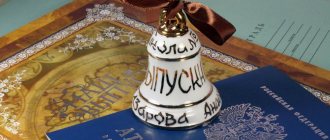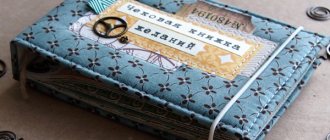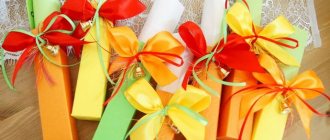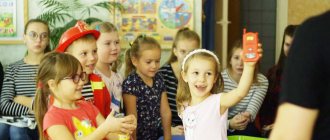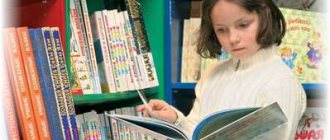In this material you can download for free a wonderful selection of cards from Little Fox Bibushi “Numbers from 1 to 10” for printing. The cards will be useful for parents, kindergarten teachers, as well as primary school teachers for teaching children and teaching children to count to 10. Here you will find 7 sets of cards, which are in separate archives for downloading in the attachments at the bottom of the page.
During lessons with cards, kids will not only get acquainted with the numbers from 1 to 10, they will remember how to write numbers correctly, will be able to independently learn to trace numbers according to a pattern, as well as perform various counting tasks and solve mathematical examples.
We have posted samples of cards for preview in the introductory material under the description. In order not to take up space on the page, we did not place samples of blue numbers up to 10; we believe that three numbers will be quite enough for the review.
If you are interested in cards with numbers from 1 to 20, you can simply click on this link to further view and download materials. Rate our work - don’t be lazy to write your reviews!
“Numbers from 1 to 10” for printing in pictures.
You can print these bright and colorful picture cards with numbers from 1 to 10 on a color printer (A-4 paper). Cut each form into four parts along the indicated lines - and start teaching your child. Using these cards, you can independently come up with various tasks for kids, for example, similar to those that we have placed on the fourth form of the manual.
Download numbers - coloring pages from 1 to 10 with tasks.
These cards are good because during classes the child can combine learning with drawing. If you notice that your baby is tired and has stopped perceiving information carefully, take a break and invite your child to color pictures with a number that he has already learned. This way, the child will have a rest and will be happy to start learning the next number.
On the fourth form you will find two counting tasks for kids to reinforce the material covered. In addition, in the second task the child is asked to complete the patterns on the mittens in a mirror image. You can easily create such examples yourself using numbers, pictures and mathematical symbols that you print on the page.
Children's birthday 1 year old: how to use numbers
Let everyone around you at the party just shout that today is your baby’s first birthday. And not only themed decorations, outfits, and treats will help with this. But also the number 1, which can be used in various ways:
- Be sure to add the words “I’m 1 year old” to your holiday garland. Let guests see from the threshold what the holiday is dedicated to.
- It's fun to make hanging garlands with numbers. Decorate each unit in accordance with the chosen theme.
- To decorate dishes, sweets, drinks, use toppers with a picture or in the form of a single.
- Lay out the unit on the wall with balls, bows, or make such a decoration out of paper.
- The photo zone must have a volumetric or flat number, which will later remind you of when the photographs were taken.
And most importantly, a large decorative number, which will practically become the central attribute of the name day. It can be miniature or huge, flat or voluminous.
This decor can be easily ordered or bought ready-made. But a do-it-yourself number for your 1st birthday will look much more interesting. Indeed, in this case, you can take into account the chosen theme, the baby’s outfit, and the size of the room.
And most importantly, preparing for any holiday brings relatives closer and gives it special significance.
How to write numbers from 1 to 10 correctly.
This manual will be useful to you after your child has learned and memorized 10 printed numbers well. In order for a child to learn to write capital numbers correctly, it is first necessary to demonstrate to the child the sequence of writing them using arrows using a clear example. Place the form on the table in front of the child, take a pen or pencil, and start circling the first number from the indicated point in the direction of the arrows, then invite the child to do the same. Then the second, third and so on, depending on how quickly the child remembers the writing sequence.
The form must be in sight of the child at all times so that he can check himself at any time. After the child has memorized these rules, you can proceed to the seventh point of this page, where the child needs to circle the numbers by dots, guided by this manual.
How to decorate one for a birthday
We offer several original options for decorating the number 1 with your own hands from scrap materials. Save these master classes for yourself - they will definitely come in handy for decorating three-dimensional figures for other children's parties.
Number 1 in eco-style made of twine, threads
A very simple option for decorating a flat piece. We will need regular twine and glue.
Gradually apply glue to the cardboard. Wrap the treated area with twine. You can make neat turns, or you can slightly change the angle of inclination. When you have wrapped the glued area, apply glue higher and continue winding the twine.
When you have wrapped the entire piece, leave the number to dry. Almost one is ready. But if desired, the twine can be painted with acrylic paints or decorative elements can be added.
But you can initially use not twine, but bright threads with which we will wrap the cardboard blank.
Number 1 from napkins for a boy's birthday
Make the fluffiest birthday number for your little one.
This will require colorful napkins, a lot of napkins and patience. But the result is worth it.
This decor will be much cheaper than ready-made figures.
We buy several packages of blue or blue plain napkins.
If you want to dilute the blue background with white flowers, purchase napkins of the appropriate color. The numbers with a smooth color transition look very cool. In this case, you will need napkins in blue, light blue, sky and white.
To make napkin flowers, it is better to take single-layer napkins. Without unfolding, fold the napkin twice. It is not necessary to cut the squares; in the future, all folds will be cut off. We fasten the workpiece in the middle with a stapler. You can use regular wire to secure the base of the flower.
Now we cut the square to the size of the flower to make an even circle.
We carefully collect the first layer of the napkin upward, forming flower petals. We perform this operation with each subsequent layer. Once you have lifted all the layers, spread out all the petals.
If you want to make a more magnificent flower, take two napkins. You can also cut the round blank into several petals without cutting to the base.
We decorate a cardboard blank with ready-made flowers. It is better to do this with glue in a gun.
After pasting with napkin flowers, you get a beautiful lush number 1.
Number 1 for a girl's birthday made of corrugated paper
Corrugated paper roses look great. A number decorated with such flowers will become a chic decoration for the anniversary. You can get creative, experiment with the color and arrangement of multi-colored flowers, or just make a single-color unit.
You will need quite a lot of corrugated paper, and also time to make a lot of blank flowers.
Unfold the paper and cut strips from it. The folds on the workpiece should be located across. The width of such a blank will be 3.5 cm. But decide on the length yourself. It can be 20 or 50 cm. The longer the strip, the more magnificent the rose will be.
We slightly stretch one side of the strip and bend its edge. By stretching the folds you should get beautiful waves.
We bend the edge and form a curl.
We begin to collect the flower itself, for which, holding the edge, we begin to twist a strip of paper around the base.
When the entire strip is folded, the bottom of the flower must be secured with an elastic band or thread.
The first rose is ready. But you need to make another 50, 100, 300 flowers.
We cover the cardboard base of the number with paper.
This will help hide possible gaps that may occur during gluing.
Glue the finished flowers to the base using PVA glue or a hot glue gun.
The result is a beautiful decorative piece that will invariably please the birthday girl.
Other uses for corrugated paper
Don't have the time or desire to tinker with corrugated paper roses? Take advantage of simpler ways to decorate a unit using it.
It is enough to cut multi-colored corrugated paper into squares.
To do this, we fold the blank strips several times and cut them along the resulting folds.
We will get a lot of corrugated squares.
Lubricate the cardboard base with glue. Take a pencil and wrap it in corrugated paper so that the rod is in the center.
All that remains is to dip the bottom of the flower in glue and attach it to the base, straighten the petal edges.
Gradually we cover all the walls of the cardboard blank. Try to ensure that the petals cover the entire surface of the number.
But there is a much simpler way.
We cut long strips of corrugated paper of different colors. We make cuts along the edge of each strip to create a fringe.
We begin to paste over the cardboard unit from below. Glue the first strip of fringe by applying glue to the entire part of the strip.
Stepping back a little, glue the next strip. Make sure that the next fringe overlaps an entire section of the previous one.
We continue to paste over the entire surface of the unit, changing the color of the stripes.
Birthday number 1 made from pompoms
If you have a lot of multi-colored woolen threads at home, you can use them to decorate the number 1. Only this time we will not wrap a cardboard blank, but make pompoms from the threads.
We will need two rings that must be exactly the same size. They can be cut out of thick cardboard.
Put these rings together. We gradually wrap the rings with thread. You can take a single-color thread or threads of different colors.
When the entire ring is covered with threads, cut the threads along the outer edge of the circle. At this stage you need to be especially careful so that the workpiece does not crumble.
We tie all the threads with additional thread, slightly moving the rings apart. Remove the cardboard rings and shake the resulting pompom thoroughly.
We make enough pom-poms from threads to cover the entire unit. In this way you can decorate both flat and volumetric figures.
Cards with numbers from 1 to 10 and mathematical plus and minus signs.
By downloading the fourth archive, you will receive 2 forms with numbers and mathematical plus and minus signs, which are located on sheets in frames, 6 pieces on each. Cut out the frames along the lines and you will have a wonderful set of cards for introducing your child to printed numbers and teaching your child how to count to 10.
Your main task is to convey to the child that real objects are “hidden” behind the numbers and how interesting it is to learn how to count them yourself.
During classes, give your child as many visual examples as possible from the environment in counting, unobtrusively practice with him on a walk, while eating, playing - make learning fun and interesting.
Download numbers from 1 to 10 “Blue”. Numbers and their names.
The fifth archive contains 11 cards with blue numbers from 1 to 10, starting from zero, each of which is located on a separate page. Under each number on the sheet there is also a name for the number. Additionally, we also included the mathematical signs “plus”, “minus” and “equals” in the set of cards.
When studying numbers with your child, it is necessary to direct all efforts to teach the child to compare the visual image of the number shown on the card with its quantitative value.
To print cards, use A-4 paper size. Even if you don't have a color printer, don't worry, when you print numbers on a black and white printer, the numbers will turn black.
DIY birthday number 1 made from balloons
Kids just love balloons. Even very little ones are delighted with the decor made from balloons.
Moreover, making the number 1 for a birthday from balloons is quite simple.
We offer a master class on making the number 1 from multi-colored balls.
We will prepare all the necessary materials and tools. We will need blue balls up to 10 cm in diameter in the amount of 52 pieces. and 36 green ones of the same size. But it is better to buy balloons with a reserve in case something goes wrong.
To inflate such a number of balloons, it is better to use the simplest pump. This will speed up the process significantly. We will tie the blanks together using fishing line.
We begin the process of making a unit by preparing the basic elements. Each segment will consist of 4 balls.
To do this, fill the balloons with air using a hand pump. At the same time, we control the size of the balls. We tie each ball.
Take 2 balls of the same color and tie them together. Let's make another one like this. We connect the two finished pieces together by twisting them. We've got the basic segment of the craft.
We make the green segment in the same way.
In total, you need to make 9 green segments and 13 blue “fours”.
Let's start making the base of the unit from green balls. We fix the fishing line on the first segment, wrapping it several times between the balls. Now we press the next green segment to it and secure it with fishing line. In this way we connect all the green “fours” with each other.
We cut the fishing line and tie the remaining tail around the balls several times and hide it.
We have the base of the number 1.
We tie a fishing line to the center of the green clearing and begin to attach the blue segments. They will go vertical. In total we will attach 10 blue segments.
From the remaining three “fours” we make the nose of the ones. To do this, we will attach the segments to the side of the vertical part. When we connect all the segments, we pull the edge of the spout to the vertical part. We cut the fishing line, tie it and hide the edge between the balls.
Our unit is ready. If desired, you can decorate it with balls of a different color, from which you can easily make a butterfly, flowers, or ladybug.
In the same way, you can make numbers in a different design.
Cards “Numbers from 1 to 10” - print each number on a separate sheet.
The sixth archive contains cards similar to the previous ones with numbers and mathematical symbols, but without names. In order to use cards for a long time, it is better to print them on thicker paper or laminate them.
It is quite difficult for a child to remember numbers, so the learning process needs to be given special attention, and most importantly, to make it fun and interesting. You need to study constantly, in a playful way, using visual materials and objects. Practice at home, on the street, in transport, in a store; such training, as a rule, brings the most unexpected results and is most effective.
If you are interested in a complete set of cards with mathematical signs and symbols for creating various examples and problems during lessons with your child, follow this link.
What numbers will we study?
As you know, in everyday life we use not only Arabic, but also Roman numerals. First of all, the child should become familiar with Arabic numerals, and only then study Roman numerals, since the latter are not used so often in practice. They indicate centuries in history books, sometimes time on clocks. Roman numerals are difficult for a child to understand. So, if the number “five” is simpler, then “four”, “seven”, etc. you need to understand how to form. Offer funny pictures for children on this topic: add a little humor to the learning so that the children show interest. This is the only way to achieve significant results.
We learn to write numbers at points from 0 to 15 according to the model.
After your child has become familiar with the correct spelling of capital numbers, invite him to complete these tasks independently. Here he will need to circle the numbers starting from zero to 15, as well as the mathematical signs “plus”, “minus” and “equals”. Monitor your child's actions as he circles the numbers and check how well he remembers the rules for writing them. Forms with assignments can be printed in any quantity, so there is no need to scold your child if he does not do penmanship well the first time.
You can also use our copybooks for children with numbers, coloring pages and pictures for download if you follow this link
